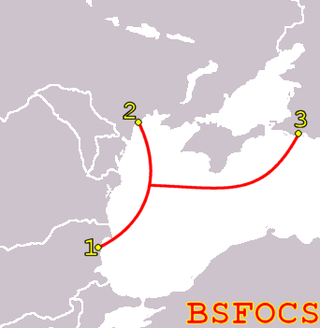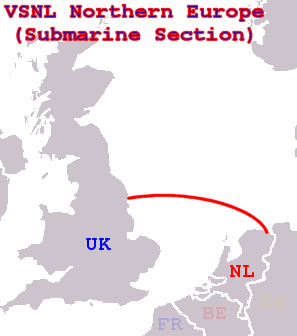
ATLANTIS-2 is a fiber optic transatlantic telecommunications cable connecting Argentina, Brazil, Senegal, Cape Verde, Spain's Canary Islands and Portugal. It is the first submarine cable to link South America and the African continent.

The Svalbard Undersea Cable System is a twin submarine communications cable which connects Svalbard to the mainland of Norway. The two optical fiber cable consist of two segments, from Harstad to Breivika in Andøy, and from Breivika to Hotellneset near Longyearbyen in Svalbard. The segments from Harstad to Breivika are 74 and 61 kilometers long, respectively, and the segments from Breivika to Hotellneset 1,375 and 1,339 kilometers. Each consists of eight fiber pairs and there are twenty optical communications repeaters on each segment. Each segment has a speed of 10 gigabits per second (Gb/s), with a future potential capacity of 2,500 Gbit/s. The system is now the sole telecommunications link to the archipelago.
SEA-ME-WE3 or South-East Asia - Middle East - Western Europe 3 is an optical submarine telecommunications cable linking those regions and is the longest in the world. Completed in late 2000, it is led by France Telecom and China Telecom, and is administered by Singtel, a telecommunications operator owned by the Government of Singapore. The Consortium is formed by 92 other investors from the telecom industry. It was commissioned in March 2000.

South East Asia–Middle East–Western Europe 4 is an optical fibre submarine communications cable system that carries telecommunications between Singapore, Malaysia, Thailand, Bangladesh, India, Sri Lanka, Pakistan, United Arab Emirates, Saudi Arabia, Egypt, Italy, Tunisia, Algeria and France. It is intended to be a complement to, rather than a replacement for, the SEA-ME-WE 3 cable.
Optical networking is a means of communication that uses signals encoded in light to transmit information in various types of telecommunications networks. These include limited range local-area networks (LAN) or wide area networks (WANs), which cross metropolitan and regional areas as well as long-distance national, international and transoceanic networks. It is a form of optical communication that relies on optical amplifiers, lasers or LEDs and wavelength-division multiplexing (WDM) to transmit large quantities of data, generally across fiber-optic cables. Because it is capable of achieving extremely high bandwidth, it is an enabling technology for the Internet and telecommunication networks that transmit the vast majority of all human and machine-to-machine information.

The Black Sea Fiber-Optic Cable System (BSFOCS) is a 1,300 km (808 mi) submarine telecommunications cable system linking three countries bordering the Black Sea. It went into operation in September 2001, and has a total capacity of 20 Gbit/s along 2 fiber pairs.

MedNautilus is a submarine telecommunications cable system linking countries bordering the Eastern/Central Mediterranean Sea. It is a successor of the LEV system linking Cyprus, Israel and Italy.
APCN or Asia-Pacific Cable Network is a submarine telecommunications cable system linking nine Asian countries.
G-P is a submarine telecommunications cable system in the North Pacific Ocean linking the two named territories.

The physical-layer specifications of the Ethernet family of computer network standards are published by the Institute of Electrical and Electronics Engineers (IEEE), which defines the electrical or optical properties and the transfer speed of the physical connection between a device and the network or between network devices. It is complemented by the MAC layer and the logical link layer. An implementation of a specific physical layer is commonly referred to as PHY.
SAm-1 is an optical submarine communications cable. It started operations in 2000, connecting the United States, Puerto Rico, Brazil, Argentina, Chile, Peru and Guatemala. In 2007, SAm-1 was extended to reach Ecuador and Colombia.
TGN Atlantic (TGN-A) previously VSNL Transatlantic and TGN Transatlantic, is a submarine telecommunications cable system transiting the Atlantic Ocean. The cable has been in operation since 2001.
VSNL Western Europe is a telecommunications cable system with both submarine and terrestrial parts linking several counties in western Europe.

VSNL Northern Europe is a telecommunications cable system with both submarine and terrestrial parts, connecting England and the Netherlands.
St. Maarten Puerto Rico-1 (SMPR-1) is an 8-pair non-repeated submarine telecommunications cable system of 375 km which uses wavelength-division multiplexing (WDM) technology to link St. Maarten and Puerto Rico.
NorSea Com-1, now called Tampnet, is a submarine telecommunications cable system in the North Sea linking the UK and Norway, and connecting five off-shore platforms.
The Matrix Cable System (MCS) is a submarine telecommunications cable linking Indonesia and Singapore with a 2nd phase to Landing at Perth, Australia. It was constructed by Tyco.
BERYTAR is a submarine telecommunications cable system in the Mediterranean Sea linking Syria and Lebanon.
KINYRAS is a domestic submarine telecommunications cable system in the Mediterranean Sea along the coast of Cyprus.
Honotua is a submarine communications cable system that connects several islands of French Polynesia via Tahiti to Hawaii. The cable was laid by the cableship Île de Ré (câblier) between December 2009 and June 2010.







